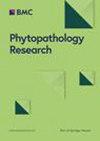Genetic diversity of field Fusarium asiaticum and Fusarium graminearum isolates increases the risk of fungicide resistance
IF 3.5
2区 农林科学
Q2 PLANT SCIENCES
引用次数: 0
Abstract
Abstract Fusarium head blight (FHB) caused by Fusarium species, seriously threatens the safety of wheat ( Triticum aestivum ) production. Resistant cultivars and fungicides are frequently used to control these FHB pathogens. However, Fusarium species have been adapting the current FHB control approaches in a manner that raises concern for future FHB control strategies, which could lead to a greater risk of FHB outbreaks. In this study, a total of 521 strains of Fusarium were isolated from Sichuan province of China, to investigate the diversity of Fusarium species and the genes associated with their adaptation. Seven species were identified based on molecular markers and morphological analysis. The virulence assays showed that Fusarium asiaticum (Fa) and Fusarium graminearum (Fg) were the two major causal agents of FHB, with high virulence and more frequent isolates. Fungicide resistance analysis showed that four isolates had developed the resistance to carbendazim, and four isolates had developed the resistance to tebuconazole. Of note, two point-mutation variants (F200Y and E198Q) occurred in the β2-tubulin gene, leading to the carbendazim resistance. The landscape of genomic diversity was analyzed through whole-genome sequencing, revealing a total of 182,811 and 430,733 variants (including: single nucleotide polymorphisms, SNP, insertion and deletion, Indel, and structure variation, SV) among the Fa and Fg isolates, respectively. In addition, potential alterations in gene function (15.22%) were predicted among Fg variants. These alterations offer potential helps for the Fusarium species to adapt to various managements of FHB, which may increase risks in developing fungicide-resistant isolates. However, these annotated genetic variants are valuable resources for further genetic and genomic studies, as well as potential markers to assist disease risk assessment.田间亚洲镰刀菌和谷物镰刀菌分离物的遗传多样性增加了杀菌剂抗性的风险
摘要赤霉病(Fusarium head blight, FHB)是由镰刀菌引起的一种疫病,严重威胁小麦(Triticum aestivum)的生产安全。抗性品种和杀菌剂经常用于控制这些FHB病原体。然而,镰刀菌一直在适应目前的食物毒素控制方法,这引起了人们对未来食物毒素控制策略的关注,这可能导致更大的食物毒素暴发风险。本研究从中国四川省分离了521株镰刀菌,研究了镰刀菌的物种多样性及其适应相关基因。通过分子标记和形态分析鉴定出7种。毒力测定结果表明,亚洲镰刀菌(Fa)和谷物镰刀菌(Fg)是FHB的两种主要病原,毒力高,分离频率高。4株菌株对多菌灵产生耐药性,4株菌株对戊康唑产生耐药性。值得注意的是,β2-微管蛋白基因发生了两个点突变变异(F200Y和E198Q),导致多菌灵耐药。通过全基因组测序分析了菌株Fa和Fg的基因组多样性格局,分别发现了182,811和430,733个变异(包括:单核苷酸多态性、SNP、插入和缺失、Indel和结构变异SV)。此外,在Fg变异中预测基因功能的潜在改变(15.22%)。这些变化为镰刀菌种适应FHB的各种管理提供了潜在的帮助,这可能增加开发抗杀菌剂分离株的风险。然而,这些注释的遗传变异是进一步遗传和基因组研究的宝贵资源,也是协助疾病风险评估的潜在标记。
本文章由计算机程序翻译,如有差异,请以英文原文为准。
求助全文
约1分钟内获得全文
求助全文

 求助内容:
求助内容: 应助结果提醒方式:
应助结果提醒方式:


